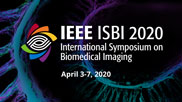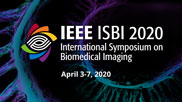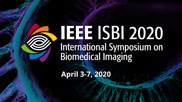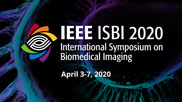
Showing 451 - 459 of 459
- IEEE MemberUS $11.00
- Society MemberUS $0.00
- IEEE Student MemberUS $11.00
- Non-IEEE MemberUS $15.00
Learning to Detect Brain Lesions from Noisy Annotations
Supervised training of deep neural networks in medical imaging applications relies heavily on expert-provided annotations. These annotations, however, are often imperfect, as voxel-by-voxel labeling of structures on 3D images is difficult and laborious. In this paper, we focus on one common type of label imperfection, namely, false negatives. Focusing on brain lesion detection, we propose a method to train a convolutional neural network (CNN) to segment lesions while simultaneously improving the quality of the training labels by identifying false negatives and adding them to the training labels. To identify lesions missed by annotators in the training data, our method makes use of the 1) CNN predictions, 2) prediction uncertainty estimated during training, and 3) prior knowledge about lesion size and features. On a dataset of 165 scans of children with tuberous sclerosis complex from five centers, our method achieved better lesion detection and segmentation accuracy than the baseline CNN trained on the noisy labels, and than several alternative techniques.
- IEEE MemberUS $11.00
- Society MemberUS $0.00
- IEEE Student MemberUS $11.00
- Non-IEEE MemberUS $15.00
Multiple Instance Learning Via Deep Hierarchical Exploration for Histology Image Classification
We present a fast hierarchical method to detect a presence of cancerous tissue in histological images. The image is not examined in detail everywhere but only inside several small regions of interest, called glimpses. The final classification is done by aggregating classification scores from a CNN on leaf glimpses at the highest resolution. Unlike in existing attention-based methods, the glimpses form a tree structure, low resolution glimpses determining the location of several higher resolution glimpses using weighted sampling and a CNN approximation of the expected scores. We show that it is possible to perform the classification with just a small number of glimpses, leading to an important speedup with only a small performance deterioration. Learning is possible using image labels only, as in the multiple instance learning (MIL) setting.
- IEEE MemberUS $11.00
- Society MemberUS $0.00
- IEEE Student MemberUS $11.00
- Non-IEEE MemberUS $15.00
Multi-Branch Deformable Convolutional Neural Network with Label Distribution Learning for Fetal Brain Age Prediction
MRI-based fetal brain age prediction is crucial for fetal brain development analysis and early diagnosis of congenital anomalies. The locations and directions of fetal brain are randomly variable and disturbed by adjacent organs, thus imposing great challenges to the fetal brain age prediction. To address this problem, we propose an effective framework based on a deformable convolutional neural network for fetal brain age prediction. Considering the fact of insufficient data, we introduce label distribution learning (LDL), which is able to deal with the small sample problem. We integrate the LDL information into our end-to-end network. Moreover, to fully utilize the complementary multi-view data of fetal brain MRI stacks, a multi-branch CNN is proposed to aggregate multi-view information. We evaluate our method on a fetal brain MRI dataset with 289 subjects and achieve promising age prediction performance.
- IEEE MemberUS $11.00
- Society MemberUS $0.00
- IEEE Student MemberUS $11.00
- Non-IEEE MemberUS $15.00
A Univariate Persistent Brain Network Feature Based on the Aggregated Cost of Cycles from the Nested Filtration Networks
A threshold-free feature in brain network analysis can help circumvent the curse of arbitrary network thresholding for binary network conversions. Here, Persistent Homology is the inspiration for defining a new aggregation cost based on the number of cycles, or for tracking the first Betti number in a nested filtration network within the graph. Our theoretical analysis shows that the proposed aggregated cost of cycles (ACC) is monotonically increasing and thus we define a univariate persistent feature based on the shape of ACC. The proposed statistic has advantages compared to the First Betti Number Plot (BNP1), which only tracks the total number of cycles at each filtration. We show that our method is sensitive to both the topology of modular networks and the difference in the number of cycles in a network. Our method outperforms its counterparts in a synthetic dataset, while in a real-world one it achieves results comparable with the BNP1. Our proposed framework enriches univariate measures for discovering brain network dissimilarities for better categorization of distinct stages in Alzheimer?s Disease (AD).
- IEEE MemberUS $11.00
- Society MemberUS $0.00
- IEEE Student MemberUS $11.00
- Non-IEEE MemberUS $15.00
Weakly-Supervised Brain Tumor Classification with Global Diagnosis Label
There is an increasing need for efficient and automatic evaluation of brain tumors on magnetic resonance images (MRI). Most of the previous works focus on segmentation, registration, and growth modeling of the most common primary brain tumor gliomas, or the classification of up to three types of brain tumors. In this work, we extend the study to eight types of brain tumors where only global diagnosis labels are given but not the slice-level labels. We propose a weakly supervised method and demonstrate that inferring disease types at the slice-level would help the global label prediction. We also provide an algorithm for feature extraction via randomly choosing connection paths through class-specific autoencoders with dropout to accommodate the small-dataset problem. Experimental results on both public and proprietary datasets are compared to the baseline methods. The classification with the weakly supervised setting on the proprietary data, consisting of 295 patients with eight different tumor types, shows close results to the upper bound in the supervised learning setting.
- IEEE MemberUS $11.00
- Society MemberUS $0.00
- IEEE Student MemberUS $11.00
- Non-IEEE MemberUS $15.00
Automated Instance Segmentation and Keypoint Detection for Spine Imaging Analysis
1.INTRODUCTION Individuals diagnosed with degenerative bone diseases such as osteoporosis are more susceptible to vertebral fractures which comprise almost 50% of all osteoporotic fractures in the United States per year. Thoracolumbar vertebral body fractures can be classified as wedge, biconcave, or crush, depending on the anterior (Ha), middle (Hm), and posterior (Hp) heights of each vertebral body. However, determining these height measurements in clinical workflow is time-consuming and resource intensive. Instance segmentation and keypoint detection network designs offer the ability to determine Ha, Hm, and Hp, in order to classify deformities according to the semi- or fully quantitative method. We investigated the accuracy of such algorithms for analyzing sagittal spine CT and MR images. 2.MATERIALS AND METHODS Sagittal spine MRI (998) and CT scans (35) were split into training and testing data. The training set was augmented (?15?rotation, ?30% contrast and brightness, random cropping) to a final size of 5667 vertebrae (1269 CT & 4398 MR). A testing set of 238 MR and 15 CT scans was used to evaluate the neural network. Mask RCNN (architecture for basic instance segmentation) was modified to include a 2D- UNet head (for better segmentation) along with a Keypoint RCNN network to detect 6 relevant vertebral keypoints (network design in Figure 1 w/one network per imaging modality). The effectiveness of the neural network was measured using two parameters: Dice score (ranges from 0 to 1 where 1=predicted overlay is manually segmented ground truth) and keypoint error distance (distance of predicted key-point location compared to manually labeled reference point). 3.RESULTS The neural network achieved an overall Dice coefficient of 0.968 and key-point error distance of 0.984 millimeters on the testing dataset. Mean percent error in Ha, Hm, and Hp height calculations (based on keypoints) was 0.13%.The neural network was able to process each scan slice with a mean time of 1.492 seconds. 4.CONCLUSIONS The neural network was able to determine morphometric measurements for detecting spinal fractures with high accuracy on sagittal MR and CT images. This approach could simplify the screening, detection of changes, and surgical planning in patients with vertebral deformities and fractures by reducing the burden on radiologists who have to do measurements manually.
- IEEE MemberUS $11.00
- Society MemberUS $0.00
- IEEE Student MemberUS $11.00
- Non-IEEE MemberUS $15.00
Generative union of surfaces model: Deep architectures re-explained
In signal processing, the union of subspaces (UoS) model is widely used to represent a signal. This model provides foundation for the low-rank methods, dictionary learning and so on, which are usually used as a prior in compressed sensing. These methods are well-understood with rich theoretical guarantees. The performance of these methods was challenged by deep architectures. In this work, we would like to develop a generative model called union of surfaces (UoSs) model, which can enjoy the benefits of both classical methods and deep architectures. We will develop this generative model by discussing a) how to learn the generative surfaces from training data, and b) how to learn a function from training data.
- IEEE MemberUS $11.00
- Society MemberUS $0.00
- IEEE Student MemberUS $11.00
- Non-IEEE MemberUS $15.00
Neural networks in tomographic imaging: how much can they learn?
We aim to incorporate deep learning throughout the imaging chain. An overview of deep learning opportunities in tomographic imaging (CT and PET) is presented.
- IEEE MemberUS $11.00
- Society MemberUS $0.00
- IEEE Student MemberUS $11.00
- Non-IEEE MemberUS $15.00
Localization of the Epileptogenic Zone Using Virtual Resection of Magnetoencephalography (MEG)- Based Brain Networks
About two-thirds of patients with drug-resistant epilepsy (DRE) achieve seizure freedom after resection of the epileptogenic zone (EZ). Functional connectivity (FC) analysis may be valuable for increasing the success rate. A spectral graph measure based on virtual resection called control centrality (CoC) has been used with ictal electrocorticography to predict postoperative seizure outcome. Our study investigated whether CoC can be used with resting-state magnetoencephalography (rs-MEG) to localize the EZ. The performance of CoC was compared to that of another spectral measure called eigenvector centrality (EVC). EVC had greater sensitivity while CoC had greater specificity in localizing the EZ. This suggests that these measures are complementary and may be valuable for pre-surgical evaluations.
 Cart
Cart Create Account
Create Account Sign In
Sign In








